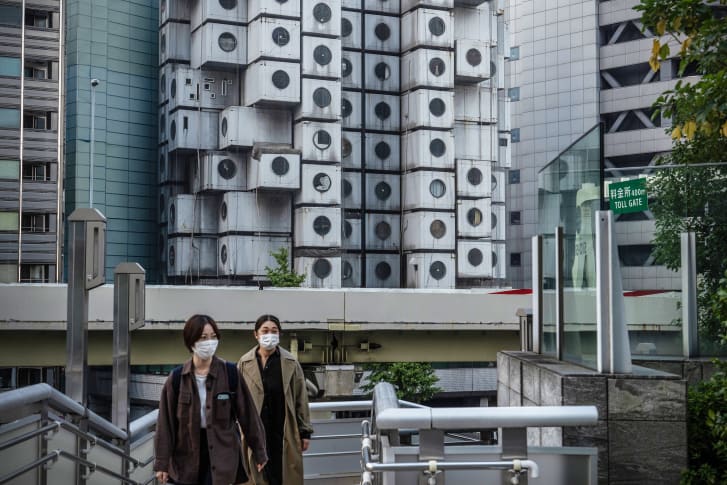일본 도쿄의 상징 캡슐 타워빌딩 다 헐어낸다. 무엇때문일까? 사진에서 볼때는 마치 꿀을 채취하기위한 벌통같아 보이기도하고, 여러개의 Amplifier의 스피커를 모아놓은것 같기도하고....그런데 이빌딩이 철거하게 된다는 것이다.
눈요기감으로 최고의 인기를 끌었던 이빌딩은 앞으로 도심지역에서 살아가는 공간으로서는 최고의 구조라고 평가되기도 했었지만, 최근에는 흉물로 전락하고 만것이 이번 철거의 원인이 됐다는 것이다. 1972년도에 완성된 이건물은 2개의 공장건물에 144개의 유니트를 빌딩벽에 부쳤고, 각유니트에는 하나의 둥근 창문을 내고, 그안에는 살림도구및 가구들을 비치했다고 하고, 각방의 크기는 10 스퀘어미터 였었다.
집주인들은 2021년도에 일괄적으로 팔기로 합의가 이루어진후, Capusule Tower Building (CTB)라는 이름을 갖인 부동산회사가 구입하였는데, 이회사의 대변인 Takashi Shindo씨는 CNN과의 전화 대담에서 마지막 주인이 지난달에 이사를 완료했기에 4월12일부터 철거작업에 들어가게 됐다고 설명했다.
지구상에서는 오직 하나인 이 Capsule모양의 아파트는 이제 역사속으로 사라지게된다.
one of Japan's most distinctive works of contemporary architecture, the Nakagin Capsule Tower in Tokyo, will be demolished this month, according to the building's new owners. The decision ends years of uncertainty surrounding the eye-catching structure, which once offered a futuristic vision of urban living but had recently fallen into disrepair.
Completed in 1972, the tower comprises 144 factory-built units arranged around two concrete cores. Each 10-square-meter (108-square-foot) "capsule" features a porthole-style window, with appliances and furniture built into the structure of each home.
A furnished capsule room inside Nakagin Capsule Tower. Credit: Carl Court/Getty Images
The building is considered a prime example of Metabolism, an architectural movement that emerged from the ruins of World War II with a radical new vision for Japan's cities. As well as embracing technology and mass production, the avant-garde group's members looked to nature for inspiration, with structural components treated like organic cells that could be "plugged" into a larger whole or later replaced.
The building's designer, Kisho Kurokawa -- one of Metabolism's youngest adherents -- had originally envisaged the Tokyo tower's capsules being replaced every 25 years. But they instead grew dilapidated and outdated, with many of the apartments now sitting empty, used for storage and office space, or rented out to architecture enthusiasts on a short-term basis. In 2007, the owners' association voted to sell the tower to a property developer that intended to demolish and replace it. But the firm filed for bankruptcy during the 2008 recession, and the site's fate was thrown into years-long limbo.
Preservationists hope some of the the 108-square-foot capsules can be saved and repurposed or acquired by museums. Credit: Carl Court/Getty Images
Owners again agreed to sell in 2021, and the building was acquired by a group of real estate firms operating under the name Capusule Tower Building (CTB). A spokesperson for the joint venture, Takashi Shindo, told CNN over the phone that the last residents moved out last month, with demolition scheduled to begin April 12.
Preservationists had long expressed hope that the building might be saved -- including Kurokawa, before his death in 2007. Petitions and campaigns have called for the structure to be protected as an example of Japan's architectural heritage. (Although the Metabolism movement proved influential, very few of its proposals were ever realized, making Nakagin Capsule Tower a rare living example of the group's philosophy.)
The organization behind the conservation campaign, the Nakagin Capsule Tower Building Preservation and Regeneration Project, asked city authorities to intervene -- and even considered applying for protected status with UNESCO. But neither approach proved successful, according to project member Tatsuyuki Maeda, who acquired 15 of the capsules between 2010 and the building's sale last year."Japan does not have the legislation to preserve this kind of architectural culture," he said over the phone. "It is unfortunate that one of the country's most representative examples of modern architectural heritage will be lost."
Maeda said that efforts to raise the 2 to 3 billion yen ($16 million to $24 million) required to renovate the tower and remove asbestos were hampered by the Covid-19 pandemic. The project has since shifted focus towards raising funds to refurbish and repurpose individual units in the hope that institutions might look to acquire "unplugged" capsules. Maeda said the project has received around 80 inquiries, with the Centre Pompidou in Paris among the museums to have expressed interest in obtaining one, he added. The Museum of Modern Art in Saitama, Japan, meanwhile has a unit in its collection already.




No comments:
Post a Comment